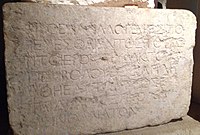Temple Warning inscription

The inscription in its current location
|
|
| Material | Limestone |
|---|---|
| Writing | Greek |
| Created | c. 23 BCE – 70 CE |
| Discovered | 1871 |
| Present location | Istanbul Archaeology Museums |
| Identification | 2196 T |
The Temple Warning inscription, also known as the Temple Balustrade inscription or the Soreg inscription, is an inscription from the Second Temple in Jerusalem, discovered in 1871 by Charles Simon Clermont-Ganneau and published by the Palestine Exploration Fund. Following the discovery of the inscription it was taken by the Ottoman authorities, and it is currently in the Istanbul Archaeology Museums.
The tablet bears the following inscription in Koine Greek:
ΜΗΘΕΝΑ ΑΛΛΟΓΕΝΗ ΕΙΣΠΟΡΕΥΕΣΘΑΙ ΕΝΤΟΣ ΤΟΥ ΠΕΡΙ ΤΟ ΙΕΡΟΝ ΤΡΥΦΑΚΤΟΥ ΚΑΙ ΠΕΡΙΒΟΛΟΥ ΟΣ Δ ΑΝ ΛΗΦΘΗ ΕΑΥΤΩΙ ΑΙΤΙΟΣ ΕΣΤΑΙ ΔΙΑ ΤΟ ΕΞΑΚΟΛΟΥΘΕΙΝ ΘΑΝΑΤΟΝ
Transliteration: ΜETHΕΝΑ ΑLLΟGΕΝE ΕΙSPOREYESTHAI ΕΝΤΟS ΤΟΥ PΕRΙ ΤΟ ΙΕRΟΝ ΤRYPHΑΚΤΟΥ ΚΑΙ PΕRΙΒΟLΟΥ ΟS D ΑΝ LEPHTHE ΕΑΥΤOΙ ΑΙΤΙΟS ΕSΤΑΙ DΙΑ ΤΟ ΕXΑΚOLΟΥTHΕΙΝ THΑΝΑΤΟΝ
Translation: "No stranger is to enter within the balustrade round the temple and enclosure. Whoever is caught will be responsible to himself for his death, which will ensue."
Clermont-Ganneau was shown a similar artifact at the Monastery of St Saviour, which was later shown to be a forgery created by Martin Boulos.
A partial fragment of the same inscription was found in 1936 by J. H. Iliffe in Jerusalem's Lion Gate, and is held in the Israel Museum.
...
Wikipedia
